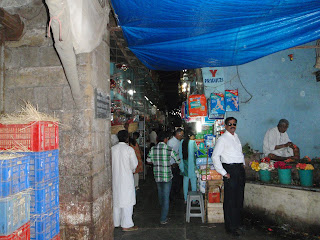IMPRESSIONS OF INDIA
10 February – 7 March 2012
In the fall of 2011, we watched a webinar from Travcoa. We liked their “Enlightened India” itinerary and decided to book the group tour for 2012. This involved several phone calls and emails with their office in California as well as booking our own air: outbound- Lufthansa from DFW to Frankfurt, Germany where we connected to a Lufthansa flight to Delhi, India; return-Jet Airways from Trivandrum, India to Mumbai, India then Lufthansa from Mumbai to Frankfurt to connect with the Lufthansa flight to DFW
Airport Security in India can be a nightmare. Passengers must have a ticket/e-ticket or boarding pass and a photo ID to even enter the terminal. Sometimes, there is another check between the terminal’s outer doors and the ticket counter. All luggage is scanned upon entry to the terminal. During the actual security check each carry-on item must have a paper tag on it and that tag is stamped after the item passes through the scanner. Each passenger passes through the detector and is then “wanded” and the boarding pass is stamped. There are separate lines for men and women. Before being allowed to board the plane, a uniformed officer checks each carry-on item to make sure it has a stamped tag.
All hotels for the trip were either five-star or the best available in that city. In order to avoid “Delhi Belly,” all meals were eaten in hotels. We only drank bottled water even using it to brush our teeth.
India’s population is 1.2 billion. That means crowding unusual to those of us unaccustomed to those conditions. There are huge economic gaps: a very few are very, very rich; a few are sort of rich; most are very, very poor. To use a current term, all US Citizens would be in the upper 1% in India. The caste system is illegal but names convey the former rank thus making the caste system still socially important. We take electricity and indoor plumbing for granted but they are unknown luxuries to most of Indian’s population. Sanitation by our definition does not exist. While the majority of the population is Hindu by religion, there are also Muslims and Christians in varying percentages depending on the area.
Marriages in India---irrespective of religion---are extravagant celebrations; some last for several days. Most marriages are arranged by the parents. While dowries are illegal under Indian law, many times the bride’s family bestows expensive and elaborate gifts on the groom’s family. In the modern world, some of the brides and/or grooms have the right of refusal. The Sunday newspaper has an entire section on “Matrimonials” with listings for both girls and boys.
DELHI
Hotel: Taj Mahal Hotel – This is a five-star hotel in the Taj group which is owned by Tata, an Indian billionaire. Security is fairly tight at the hotel with guards at the entrance gate who checked the vehicle before we proceeded up the drive. Once at the hotel entrance, our luggage was scanned before being taken inside. Our room had access to the club lounge. The room was nice with a great view; service was impeccable. In fact, one night when we realized we didn’t get any chocolates at turn down and called, the butler brought a dish of 9 chocolates which was replenished often.
Pre Tour: Upon arrival in Delhi at 1:10 a.m. Sunday, we went through Immigration and then claimed the luggage. We met the driver, loaded the luggage, and left the airport. The guide pointed out several new hotels under construction near the airport to be used by transfers and other short-term passengers; he also pointed out the elevated high speed rail connection between the airport and downtown. This rail service and the new terminal we used were built for the recent “Commonwealth Games.” The thirty-minute-drive to the hotel took us through the diplomatic area which is the “cleaned up” area most often seen by VIPs. As it was dark, it was difficult to tell much about the area. Even though there was some haze, from our room we were able to see the tip of the Lotus Temple in the distance as well as Humayan’s Tomb. A dozen or more brown birds called kites soared as they rode the thermals like buzzards in Texas. Pigeons flew furiously through air and landed on the hotel’s window ledges. On Monday there was a terrorist car bombing of an Israeli Embassy car not far from the hotel. We didn’t know it happened until we saw it on the news. On Tuesday we booked a car and driver for a shopping excursion. There were more uniformed security guards outside the hotel today than previously. Articles in the morning paper indicated that the police would be out in force after yesterday’s car bombing and we saw quite a few of them everywhere. Our first stop was “Central Cottage Industries Emporium,” a large, government-operated store which only sells products made in India. Think of it as a “Pier One” on steroids. We wandered inside a good bit but it was dirty and the staff---evidently all government employees---were disinterested. From there we drove to “Khan Market,” a shopping center. Traffic inched into and through the parking lot with many people looking for parking; our driver knew someone and we had a place. There were definitely more police visible in this shopping area. We walked along the sidewalk and into some stores.
Tour – Day 1: When we opened the drapes this morning, it was the clearest it had been any morning of our visit. Yesterday’s haze/smog was so thick that we could barely make out skyscrapers and other buildings just a few blocks away. This morning those buildings were clearly visible. Our first tour of the trip began when we met in the lobby at 1:00. We met the tour director Amber and our local guide, a Hindu lady named Poona. The drive from the hotel to Qutb Minar, located in the Mehrauli Archaelogical Park, only took about 45 minutes. While traffic was congested, it wasn’t as bad as we remembered; however, for the most part we were in the “clean city” of New Delhi. After arrival at the site---the oldest mosque in Delhi--- Poona gave a brief history and pointed out the various Hindu carvings on the thousand-year-old columns used to build the colonnades. She also gave the history of the tower itself as well as the iron pillar. Since we had been there before, it wasn’t as interesting to us as to the others.
We saw quite a few Indian families there and most were dressed in their “Sunday Best.” After leaving Qutb Minar, we inched our way through even more congested traffic for a while until we finally reached the bus lane as we made our way to Humayan’s Tomb erected in 1569. We enjoyed seeing this forerunner of the Taj Mahal constructed of red sandstone and white marble for a second time. The white dome shone in the sunlight and the gardens were very green. Water filled the channels and spewed from a fountain. After leaving the tomb, we returned to the hotel.
Tour – Day 2: It was a little cool, so we carried the coats. Our drive took us through the area of New Delhi designed by Edward Lutyens in the early 1900s. Here the bungalow-lined streets are wide and the roundabouts are landscaped. We saw the India Gate, a memorial arch for the 90,000 who died in World War I.
The central portion of the city has lots of trees, parks and landscaped areas making it one of the “greenest” cities anywhere; each of these green spaces, including the roundabouts, is occupied by people enjoying the outdoors. Our first stop was Raj Ghat Park where we visited the memorial for Gandhi erected at the site of his cremation. Shoes must be removed to enter the memorial. Many come to pay homage at this simple marble slab.

The central portion of the city has lots of trees, parks and landscaped areas making it one of the “greenest” cities anywhere; each of these green spaces, including the roundabouts, is occupied by people enjoying the outdoors. Our first stop was Raj Ghat Park where we visited the memorial for Gandhi erected at the site of his cremation. Shoes must be removed to enter the memorial. Many come to pay homage at this simple marble slab.
Then we drove into “Old Delhi” to see the way the “real Indians” live. On the way we passed ruins of a previous city. Once in “Old Delhi,” we took a rickshaw ride through Chandni Chowk. We began weaving our way through the traffic composed of vehicles of various types: motorbikes; bicycles; handcarts; buses; vans; small trucks. The cacophony of horns can be almost deafening. We noted various wares for sale in the stores.



We saw Jami Masjid, Delhi’s largest mosque, and the Red Fort and its Lahore Gate before stopping at the golden-domed Temple of Sikh Gurudwara. Here we had to remove our shoes and socks and cover our heads with cloth before entering the temple. After leaving the information room, we walked back out onto the sidewalk and then briefly into the street before wading through some water and climbing some marble steps. Some sort of service was in progress as we entered the temple as there was atonal music and chanting; offerings were being received by a priest behind a gold altar. We walked the perimeter of the room and made some photos before leaving via the back door. From there we went to the communal kitchen where lunch was being prepared. This required more barefooted walking up and down steps. We saw several people sitting around piles of pumpkins and cucumbers slicing them for cooking. In the kitchen, a machine produced dough for naan [Indian flatbread] which ladies formed into golf ball-sized pieces before rolling them flat. Across the way, the dough was cooked on a huge hot flat grill. Huge cooking pots holding forty to fifty gallons of boiling liquid sat over flames. Another held sliced pumpkin being cooked into soup. We watched a man with a gallon-sized ladle transfer liquid between pots. Then two men slid one of the pots of bubbling liquid onto a sturdy handcart. The cart was then pulled into the dining room where lines of people sat on the floor alongside long strips of matting. Each was given a metal plate divided into three parts. The diners held the plate while one man came along with a basket of naan and placed a piece on the plate; then a man came along with a bucket and ladled in some green slimy liquid; another followed and did the same with something brown. Anyone can eat here who wants. Four people sat near the doorway scraping dirty plates and there was another place where the plates were washed in water. There was no sanitation in evidence anywhere. After retracing our steps and retrieving our shoes and socks, we returned to the rickshaw to finish the ride.



We had a good peddler who pointed out sites we passed. We were intrigued with the snarls of electrical lines along buildings and over the streets. In the spice market where the mixture of aromas perfumed the air, we saw the usual conical mounds of spices in the shops. Then we went into the textile area and saw multiple shops selling fabrics, trims, saris, and clothing. One small alley contained all items needed for weddings. We had made somewhat of a circle and ended the most-enjoyable ride, which lasted at least an hour, at our starting point. The rickshaw ride was today’s highlight as our peddler skillfully wove his way around and through pedestrians and other vehicles.






We returned to the hotel about 12:15 for lunch. After going to the room and scrubbing our feet, we ate lunch in “Machan,” the hotel coffee shop. We then relaxed in the room for a few minutes before meeting the afternoon tour at 2:00. Gandhi Smrita, the first stop of the afternoon, is the place where Gandhi was assassinated in 1948. We looked at the memorial erected on that spot as well as some information on his life and on “The Freedom Movement.”
We passed the ruins of a fort erected by Shah Jahan before driving into the governmental area which the locals call “Babu Land.” [A babu is a person who sits around and does nothing when he should be working.] Here we saw buildings erected during the British Raj which house the governmental offices and bureaucrats. In one area monkeys sat atop a wall while men waited across the street to catch a bus.

We passed the ruins of a fort erected by Shah Jahan before driving into the governmental area which the locals call “Babu Land.” [A babu is a person who sits around and does nothing when he should be working.] Here we saw buildings erected during the British Raj which house the governmental offices and bureaucrats. In one area monkeys sat atop a wall while men waited across the street to catch a bus.


Sansad Bhavan, the parliament house, is round and reminiscent of an arena. After another view of India Gate and the black domed prime minister’s residence, we went to Cottage Industries. This was not the same location we went to earlier in the week and was much cleaner

VARANASI
Hotel: Taj Gateway Hotel - While the hotel is rated four-star and horns are still audible from the room, it’s an oasis of luxury in Varanasi’s squalor.
Tour – Day 3: The flight to Varanasi was uneventful. Varanasi is considered by many to be the oldest inhabited city on Earth. Krishna, our guide, spoke as we rode the bus to the hotel where we ate a buffet lunch. We left at 2:30 for the drive to Sarnath, site of Buddha’s first sermon. During the drive, Krishna lectured on “Buddhism 101.” Once at the site, we saw the temple erected in 1930 after a Sri Lankan Buddhist priest rediscovered it in 1890. The interior contains a painting of the life of Buddha in somewhat muted colors. The entire area had been destroyed centuries ago by Muslim invaders. We then saw the ancient brick stupa marking the site of the actual sermon as well as the ruins of another stupa which held relics. Excavations by the British were conducted here during the Raj. After leaving Sarnath, Buddhism’s holiest site, Krishna spoke on Hinduism, Sikhism and Jainism. 



We returned to the hotel for a half-hour pit stop before taking the bus into downtown Varanasi. Varanasi is filthy and the poverty the worst we’ve ever seen. Everything is covered in dirt and the people themselves aren’t clean. Ramshackle would be an upscale description of any housing we saw. During this brief ride, Krishna spoke on why Hindus hold the cow sacred: the bullock pulls the plow; milk nourishes children; dung provides fuel and fertilizer; leather provides products. He also pointed out that beef is not really a suitable meat for consumption in the Indian climate.



Situated on the Sacred Ganges River and between the Varum and Asi Rivers, this is a very holy city for Hindus. Each Hindu hopes to visit Varanasi at least once during life and to have their cremated ashes places into the waters of the sacred Ganges River here after death. At that point we began the interesting and nerve wracking “Rickshaw Ride of Terror” as we were conveyed through the downtown market area to the banks of the Ganges. Anarchy is the only word that even begins to describe the determined, deliberate and demented chaos as cars, vans, tuk-tuks, rickshaws, bicycles, handcarts, cows and pedestrians competed for passage. Many near misses, standstills, and deadlocks occurred. Strident cacophony is an inadequate description of the noise as horns on all motorized vehicles are in constant use; it’s headache producing. Varanasi is the place where many Hindus come to die and there were times when we were not sure that we had not done the same.




Once near the river, we disembarked and threaded our way through the crowd of worshipers, beggars and vendors as we made our way down concrete steps to the water. The ceremony led by seven priests was already in progress on a riverside platform. We boarded a wooden rowboat, elliptical in shape, with padded seats along the sides; a boy sat in the stern and rowed with long oars consisting of a flat board attached to a long bamboo pole. After clearing the flotilla just off shore, we sailed out into the river itself where Krishna intoned a Hindu prayer and we released floating candles into the river. They made a line of twinkling light on the dark surface. We were rowed farther upriver toward the crematorium where some 150 bodies are cremated each day. We saw at least three fires burning.
We then floated back to the edge of the flotilla where the ceremony was a blaze of light with synchronized movements by the priests and chants blared by loudspeakers. After watching this for a while, the boys rowing our boat began to nudge our boat through the seemingly solid mass; they performed this effortlessly and matter-of-factly. Almost before we knew it, we were disembarking at the steps while the ceremony continued. From there we had to climb the steps, and run the gauntlet again before reaching our rickshaw. The ride back was equally as heart-stopping as the one in. We did note a cow lying inside one of the shops just as if she were a house pet. After reboarding the bus, we drove back to the hotel arriving about 8:00. A Hindu wedding celebration added color and rhythmic drumming to the front garden for a while and there was a parade of lights with men carrying huge electrified candelabras. It moved to another location but fireworks sounded like a cannonade after we went to bed.
Tour – Day 4: We left the hotel at 5:30 a.m. and drove father into the city than we were able to last night; the streets were almost empty and the stores and shops were closed. We walked quite a way through the market area seeing sleeping cows and sleeping people in doorways. Returning to the same embarkation point as last night, we boarded the same boat and were afloat on the Ganges when the sun rose.
People come to the ghats [steps] for religious purposes as the Ganges River is thought to be the mother in the Hindu religion. Many simply wade into the water at various depths up to about waist deep.
Some completely immerse themselves and many of these only wear underwear. We also saw some people drinking the water while others scooped it up in offering to the rising sun. Some offered flowers or sweets.

A vast panoply of worshipers presented itself at waterside and we enjoyed it all because we were between the worshipers and sun.
In one area people were doing laundry by immersing the linens in the river and then beating them on especially built stone tables at the river’s edge. They are then spread on the nearby steps and ground to dry.
After traveling as far as the smaller crematorium, which was not in use, we turned and went back.
A cremation using wood costs about 4,000 rupees and takes about two or three hours; one using electricity costs 400 rupees and takes about one hour. The more expensive one is preferred. Cremation usually takes place only a few hours after death and then the cremains are thrown into the Ganges. Mourning lasts for thirteen days. We left the river and walked back to the bus. There were many “holy men” and beggars this morning. All wanted money. These beggars were mostly adults and many were men either missing an arm or leg or with deformed limbs. Almost all the time ashore, the group was accompanied by three boys---deaf mute brothers---who helped us avoid traffic and up and down steps; Krishna paid them.

We then floated back to the edge of the flotilla where the ceremony was a blaze of light with synchronized movements by the priests and chants blared by loudspeakers. After watching this for a while, the boys rowing our boat began to nudge our boat through the seemingly solid mass; they performed this effortlessly and matter-of-factly. Almost before we knew it, we were disembarking at the steps while the ceremony continued. From there we had to climb the steps, and run the gauntlet again before reaching our rickshaw. The ride back was equally as heart-stopping as the one in. We did note a cow lying inside one of the shops just as if she were a house pet. After reboarding the bus, we drove back to the hotel arriving about 8:00. A Hindu wedding celebration added color and rhythmic drumming to the front garden for a while and there was a parade of lights with men carrying huge electrified candelabras. It moved to another location but fireworks sounded like a cannonade after we went to bed.
Tour – Day 4: We left the hotel at 5:30 a.m. and drove father into the city than we were able to last night; the streets were almost empty and the stores and shops were closed. We walked quite a way through the market area seeing sleeping cows and sleeping people in doorways. Returning to the same embarkation point as last night, we boarded the same boat and were afloat on the Ganges when the sun rose.

People come to the ghats [steps] for religious purposes as the Ganges River is thought to be the mother in the Hindu religion. Many simply wade into the water at various depths up to about waist deep.

Some completely immerse themselves and many of these only wear underwear. We also saw some people drinking the water while others scooped it up in offering to the rising sun. Some offered flowers or sweets.


A vast panoply of worshipers presented itself at waterside and we enjoyed it all because we were between the worshipers and sun.

In one area people were doing laundry by immersing the linens in the river and then beating them on especially built stone tables at the river’s edge. They are then spread on the nearby steps and ground to dry.

After traveling as far as the smaller crematorium, which was not in use, we turned and went back.

A cremation using wood costs about 4,000 rupees and takes about two or three hours; one using electricity costs 400 rupees and takes about one hour. The more expensive one is preferred. Cremation usually takes place only a few hours after death and then the cremains are thrown into the Ganges. Mourning lasts for thirteen days. We left the river and walked back to the bus. There were many “holy men” and beggars this morning. All wanted money. These beggars were mostly adults and many were men either missing an arm or leg or with deformed limbs. Almost all the time ashore, the group was accompanied by three boys---deaf mute brothers---who helped us avoid traffic and up and down steps; Krishna paid them.
We arrived back at the hotel about 8:30 and went to breakfast. We had the bags out at 9:15 and left at 9:30 for a short drive to Menthe Silk, a weaving center. Here we saw some very old looms with the patterns memorized by the weavers. Two men are needed to operate the loom and one weaves with the shuttle while the other controls and straightens the vertical cords. This creates the pattern. There were also two card looms which weave an ikat pattern. After hearing an explanation of the process, we trooped upstairs where the owner displayed scarves.




We left for the airport at 11:45. Then we went through Security and waited in the gate area until time to board “Jet Airways” flight 723. The flight was late and we didn’t take off until about 1:20. We landed in Khajuraho about forty-five minutes later. Our guide Anoop met us in the terminal. This is a much smaller place with no real traffic and no real noise. Its main business is tourism. We deviated from the program and postponed all touring until tomorrow.
KHAJURAHO
Hotel: The Taj Chandela Hotel is only about a ten-minute drive from the airport. Here we had a garden view room.
Tour – Day 5: The ancient temples of Khajuraho were constructed during the time of the Chandela Empire. They were subsequently destroyed by invading Muslims and the jungle reclaimed the area. During the British Raj, the ruins were rediscovered and excavation and restoration begun. We visited the Eastern group of temples first. They are situated in a landscaped park and are connected by paved paths. All of the temples are constructed of sandstone blocks and have lotus-style roofs. Each block was carved on the ground and then fitted into place without mortar. They were carved to interlock. Restorers have used plain sandstone blocks to fill in for missing pieces so that the originals will stand out. Anoop used a mirror to indicate the carving under discussion. His lengthy commentary tended to become repetitious. First we visited Lakshmana Temple dedicated to Vishnu. The sculptural figures which cover the lower portion are exceptionally well done. Known to many as the erotic temple because many of the figures depict sexual poses from the “Kama Sutra,” the quality of the carving is exceptional. From there we visited the largest temple, Kandariya Mahadev. Although the sculptures are not of the quality of the previous temple, no original surface was left uncarved. We also saw Devi Jagdambi Temple but there appeared to be little of the original surface in existence. We walked by Chitrabupta Temple as we made our way back toward the gate. We left the park shortly after 11:00 and returned to the hotel for lunch.


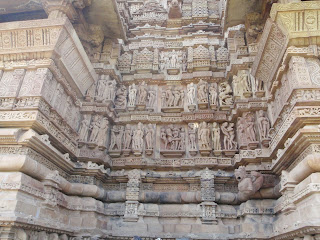



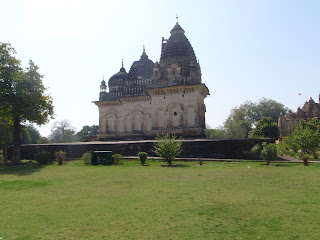
At 2:30 we left to visit the Western group of temples. The first temples were Jain temples and Anoop is Jain and thought these temples required very lengthy explanations. Parsvantha Temple and Adinatha Temple are side by side. All the temples we saw today were of the same architectural style. We then visited Duladeo Temple because it is set in a landscaped garden. 



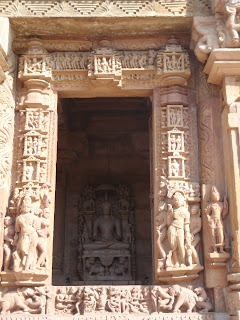
Our last stop was Chaturbhuj Temple which is the only one facing west so that an image of Shiva inside catches the last rays of the setting sun on its feet. 







Tour – Day 6: We spent an “enchanted night.” Because today is Maha Shivaratri, celebrating Lord Shiva, celebrations began early and the chanting is amplified. We heard it well inside our room. We left the hotel at 8:30. This was a strange day with little or no information as to our schedule; none of us had an inkling of what was in store. Our first stop of was “tourist village” where we visited a school attended by about 120 children who sit on the floor and learn by rote. Paint peeled from the concrete houses and the entire village and people in it were dirty. Pigs, resembling our javalinas, roamed. There were also cows. Women used a hand pump at a well to pump water into containers to carry back to their homes. When we first arrived, a cow was half way inside the doorway to one of the house. A woman used her bare hands to gather cow dung, mix it with water, and form it into patties to dry in the sun; it’s used for fuel. After leaving there, we headed out of town. The drive between Khajuraho and Orcha takes four and a half hours over extremely rough roads. Anoop went with us. Despite promises of a better bus than the previous day, this was the worst bus of the tour to date. We believe the road conditions are so terrible that the company doesn’t want to use one of its good buses on the route. We drove through several villages and towns, most of which looked unprosperous and dirty. Perhaps because it’s the dry season, a layer of dust covers everything. Even though some towns/villages have stores, there are still the decrepit pavilions and stalls selling food, merchandise and clothing. Fields of wheat and mustard filled much of the landscape. As today was a holiday, there was little labor in progress and lots of people out-and-about. Many were making pilgrimages to temples; some of these were holy men dressed in deep yellow and/or orange and carrying small buckets of water. We saw quite a few women in the larger towns as they headed for the temples or carried laundry atop their heads. Those we did see were attired in colorful saris. We made a rest stop about two hours into the trip and then it was back to bouncing our way across rural India. We saw numerous brick-making facilities. There were also quite a few uncompleted buildings and other construction projects. It was difficult to appreciate miles and miles of more of the same.We arrived in Orcha at 2:00 and ate lunch at a hotel.
Then we toured Jahangir Mahal, a fortress built by the Bundela dynasty. Sitting high on a hill, it commands the surrounding area.
We walked up and it the fort and then up even more steps. We watched the black-faced monkeys at play near the gate.


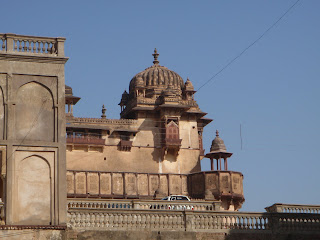


After leaving the fortress, we drove to the railway station at Shatabdi where we boarded the Shatabdi Express for Agra. The train left at 5:55 and arrived in Agra at 8:25.
AGRA
Hotel: Oberoi Amarvilas Hotel – This was our second time in this hotel. It’s very luxurious and rooms all have views of the Taj Mahal. Service is second-to-none.
Tour – Day 7: At 9:30, Rajeev, our guide, herded us into golf carts for the ride to the Taj Mahal. We enjoyed seeing the Taj Mahal again and Raj gave an excellent tour.
The weather was perfect, but it was much more crowded than our previous visit and there were additional security measures and barricades. In 2008 we had a private tour in the afternoon and stayed for sunset; then we returned the next morning for sunrise. Today we only had a two-hour tour. After the visit to the Taj Mahal, we rode golf carts back to the hotel and boarded the bus for a trip to Akbar International where we saw the artisans creating inlaid marble items.
We skipped the afternoon tour to the Agra Fort as we had seen it last time.
Tour – Day 8: We left the hotel about 10 minutes after 9:00. Our first stop was Kohinoor, a tapestry museum and jewelry store. The owner gave us a private tour of his personal collection of embroideries. These huge pieces have depth and dimension created by layering the threads. Many are also jewel encrusted. We were totally amazed at the flowers and animals portrayed.
The highlight was “The Good Shepherd” with sheep so real they almost came off the canvas; it brought tears.
Then he showed us through the collection of similar embroideries for sale before we went up and escalator to the jewelry showroom. There we met his wife, son and daughter. He showed us emeralds which belonged to Mumtaz Mahal for whom the Taj Mahal was built. We left Kohinoor about 10:30 and drove across Agra on our way to Bharatpur. Rajeev pointed out sites along the way and discussed what was happening. In one place, we waited for a large herd of water buffalo which are a source of wealth for farmers. A car hit one and Rajeev said it could cost the driver 25,000 IR in compensation. We saw thousands of the cow dung patties which are used for fuel. They dry to dinner plate to platter size and are two to three inches thick. Some are stacked in huge bee hive forms. Others are stacked atop roofs and fences. Rajeev told us that one will burn for about three hours to cook the family’s meal.
 At Fatehpur Sikri, we stopped and walked to the top of a hill for a tour. Abandoned now, it served as the capital of the Mughal Empire between 1571 and 1585. Restoration has created an almost perfect example of a Mughal city built of red sandstone. The Halls of Public and Private Audiences, Tower of Victory and the Tomb of Salim Christi were the main attractions. The huge courtyard displays a backgammon board set into the pavement on which courtiers served as the “pieces.”
At Fatehpur Sikri, we stopped and walked to the top of a hill for a tour. Abandoned now, it served as the capital of the Mughal Empire between 1571 and 1585. Restoration has created an almost perfect example of a Mughal city built of red sandstone. The Halls of Public and Private Audiences, Tower of Victory and the Tomb of Salim Christi were the main attractions. The huge courtyard displays a backgammon board set into the pavement on which courtiers served as the “pieces.”



 We entered the state of Rajasthan, the bread basket of India. Agriculture is everywhere and we saw some women in colorful saris collecting the mustard seeds. About two o’clock, we went to “Baht,” a hotel with a restaurant, for lunch. After lunch we drove a short distance to board a train. Even though we were in a first class car, these seats were much less comfortable than the previous train. We saw miles of agriculture as we rode and made some stops in what the Indians call villages and we would call towns. We reached our stop about 6:15 and got into vans which drove us to our hotel.
We entered the state of Rajasthan, the bread basket of India. Agriculture is everywhere and we saw some women in colorful saris collecting the mustard seeds. About two o’clock, we went to “Baht,” a hotel with a restaurant, for lunch. After lunch we drove a short distance to board a train. Even though we were in a first class car, these seats were much less comfortable than the previous train. We saw miles of agriculture as we rode and made some stops in what the Indians call villages and we would call towns. We reached our stop about 6:15 and got into vans which drove us to our hotel.
RANTHAMBHORE
Hotel:Oberoi Vanyavilas . Our room is a “tent.” It has a concrete foundation which extends about 4 feet along each side and about 6 feet on each end. The roof is canvas which peaks and then extends to cover the foundation. The walls are fake French doors; the bedroom has 3 sets with about 3 feet between them along one side and two sets and the entry along the other. The end is about the same but only has 2 sets because there is a TV in the center. The bed centers the room with a desk behind it. The bathroom is about half the size of the bedroom and is compartmented with a claw footed tub in the center. French doors lead out to a patio with chaise lounges. A table and chairs are outside the bedroom end.



Tour – Day 9: We left at 6:30 for our game drive in Ranthambhore National Park. After meeting our local guide, we boarded an open-topped vehicle called a cantor for the drive. We were all in the same one and it was quite cozy. Our goal was to see a Royal Bengal Tiger. A buffer area surrounds the park and is ideal habitat for leopards as they and the tigers do not share territory if at all possible.
The park is divided into zones and vehicles are assigned specific zones and not allowed into others; ours was zone three. We entered the park with the thousand-year-old ruins of Ranthambhore Fort crowning the hill above us and stayed there until about 9:30.
During that time, we saw lots of vegetation, birds, wild boar and deer. Some birds, the Rufous Treepie, make a pest of themselves because some Indian tourists feed them. They land on and around the vehicles and the passengers.
Hundreds of pea fowl, the national bird of India, inhabit the park. We saw the peahens with their subdued colors and the peacocks dragging resplendent tail feathers in all shades of blue and green. Several flew.
We sat beside a lake and watched some crocodiles, Ruddy Shelducks, Egrets, Gray Heron and a Snake Bird.
Parakeets were in a tree above us.
In another body of water we saw some Black Headed Ibis.
We saw quite a few Chital (Spotted Deer) and Sambar Deer including some stags with huge racks. As this is the mating season, we heard stags bugle.

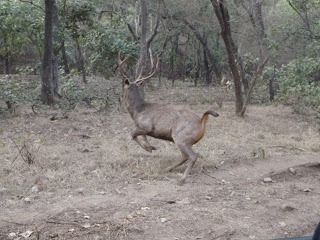
We did not see a tiger but no one in any of the other vehicles saw one either. All we saw was a tiger paw print in the sandy roadway. While it was not totally unenjoyable, it was quite disappointing. Almost everyone appeared underwhelmed when we returned to the hotel. After breakfast in the restaurant courtyard, it was about 11:00 when we returned to the room. Shortly before 3:00 we walked up to the lobby for the afternoon drive. We drove through town to get there. This time we were in zone six which was mountainous and extremely rocky. The abysmal roads were extremely, bone-jarring. We saw more wildlife: Blue Buck; Spotted Deer; Sambar;
While it was not totally unenjoyable, it was quite disappointing. Almost everyone appeared underwhelmed when we returned to the hotel. After breakfast in the restaurant courtyard, it was about 11:00 when we returned to the room. Shortly before 3:00 we walked up to the lobby for the afternoon drive. We drove through town to get there. This time we were in zone six which was mountainous and extremely rocky. The abysmal roads were extremely, bone-jarring. We saw more wildlife: Blue Buck; Spotted Deer; Sambar;
Black-Tailed Mongoose; Crested Serpent Eagle;
Gazelle.
While these were interesting and some were really excellent specimens, we did not see any tigers. As our guide spoke to those in other vehicles, they didn’t see any either.

The park is divided into zones and vehicles are assigned specific zones and not allowed into others; ours was zone three. We entered the park with the thousand-year-old ruins of Ranthambhore Fort crowning the hill above us and stayed there until about 9:30.

During that time, we saw lots of vegetation, birds, wild boar and deer. Some birds, the Rufous Treepie, make a pest of themselves because some Indian tourists feed them. They land on and around the vehicles and the passengers.

Hundreds of pea fowl, the national bird of India, inhabit the park. We saw the peahens with their subdued colors and the peacocks dragging resplendent tail feathers in all shades of blue and green. Several flew.

We sat beside a lake and watched some crocodiles, Ruddy Shelducks, Egrets, Gray Heron and a Snake Bird.

Parakeets were in a tree above us.

In another body of water we saw some Black Headed Ibis.

We saw quite a few Chital (Spotted Deer) and Sambar Deer including some stags with huge racks. As this is the mating season, we heard stags bugle.



We did not see a tiger but no one in any of the other vehicles saw one either. All we saw was a tiger paw print in the sandy roadway.
 While it was not totally unenjoyable, it was quite disappointing. Almost everyone appeared underwhelmed when we returned to the hotel. After breakfast in the restaurant courtyard, it was about 11:00 when we returned to the room. Shortly before 3:00 we walked up to the lobby for the afternoon drive. We drove through town to get there. This time we were in zone six which was mountainous and extremely rocky. The abysmal roads were extremely, bone-jarring. We saw more wildlife: Blue Buck; Spotted Deer; Sambar;
While it was not totally unenjoyable, it was quite disappointing. Almost everyone appeared underwhelmed when we returned to the hotel. After breakfast in the restaurant courtyard, it was about 11:00 when we returned to the room. Shortly before 3:00 we walked up to the lobby for the afternoon drive. We drove through town to get there. This time we were in zone six which was mountainous and extremely rocky. The abysmal roads were extremely, bone-jarring. We saw more wildlife: Blue Buck; Spotted Deer; Sambar;Black-Tailed Mongoose; Crested Serpent Eagle;

Gazelle.

While these were interesting and some were really excellent specimens, we did not see any tigers. As our guide spoke to those in other vehicles, they didn’t see any either.
We left the park about 6:00 and headed back toward the hotel. There is no way to adequately describe the drive through town. The narrow roadway is clogged with traffic composed of buses of various sizes; trucks; vans; cars; tuk-tuks; camel carts; horsemen; horse carts; bicycles; motor bikes; hand carts; pigs; cows; water buffalo; pedestrians. All of these weave and jockey for position as they careen down the roadway; they stop whenever and wherever they choose with little or no warning and the “center line” is only a suggestion. Buses are jam-packed full inside with dozens of people riding on top. Some trucks carry people in the back with capacity being as many as can squeeze in. Capacity for tuk-tuks is the same. Colorful saris brighten the dingy buildings. Everything is completely covered with several inches of dust. Despite all this, life for the Indian people goes on and nobody appears to notice anything amiss. We got back to the hotel about 6:30





JAIPUR
Hotel: Our hotel, the Oberoi Rajvillas, was erected about ten years ago on the outskirts of Jaipur, capital of Rajasthan. Nearby is a large parking area for trucks waiting to enter the city; they can only do this at night. It’s amazing how lush, green and clean the hotel is when it’s surrounded by dilapidated, dingy and dirty structures. Once again the hotel grounds are several acres of garden. There is a central lobby with restaurants. Individual rooms are housed in buildings scattered over the grounds with each building containing six large rooms. All bathrooms have sunken tubs and enclosed gardens. Some rooms are tents like the previous hotel but none of our group was in one.
Tour – Day 10: Our 9:30 leaving was some 10 to 15 minutes late, but we were soon on the road for Jaipur. We had Raj, our new guide, aboard. He did his best to offer explanations and to answer questions as we rode. We drove through the town and onto the highway, a two-land road. Along the roadsides were scenes of rural India: fields of mustard; fields of wheat; rows of marigolds for offering necklaces; water buffalo; cows; chickens; pigs; women wearing bright saris; men laboring at trades; farmers. As we drove through the villages, we saw the usual shops and stalls selling everything needed for daily life. As it is the dry season, dust covers everything. After a while, the squalor and the filth began to eat away at us. We made a rest stop about 11:00. At 3:30, we left the hotel for a tour of the Old Pink City of Jaipur. We took the bus into and through the newer portion and through one of the old gates. We saw the Palace of the Winds before getting off the bus and walking.

Our stop was Jantar Mantar, an observatory constructed by Sawai Jai Singh II between 1728 and 1734. This site has several huge sundials which accurately tell the time. It also has a section for astrological signs so that individual horoscopes can be determined.


Our stop was Jantar Mantar, an observatory constructed by Sawai Jai Singh II between 1728 and 1734. This site has several huge sundials which accurately tell the time. It also has a section for astrological signs so that individual horoscopes can be determined.

We then boarded rickshaws for a very tame ride through the old city, around City Palace and back to the bus.
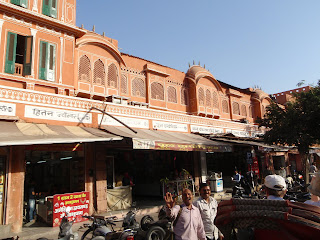







 Our next stop was Gem Palace, a jewelry store. Jaipur is the center for colored stone cutting in the world. We spent quite a while there and in another nearby store before reboarding the bus for the drive back to the hotel. Traffic was a nightmare and in one intersection many merging vehicles and stopped buses created gridlock. We finally inched through and arrived at the hotel.
Our next stop was Gem Palace, a jewelry store. Jaipur is the center for colored stone cutting in the world. We spent quite a while there and in another nearby store before reboarding the bus for the drive back to the hotel. Traffic was a nightmare and in one intersection many merging vehicles and stopped buses created gridlock. We finally inched through and arrived at the hotel.
Tour – Day 11: After breakfast, we boarded the bus for the 9:00 departure. Once again, we had to traverse the city as we made our way to the Amber Fort located on a nearby mountain. Home to Hindu royalty, it often hosted Mughal ruler Akbar. Established in the 16th century, It was the old capital until a poor water supply caused a movement to Jaipur in 1727. The color of the sandstone gave the fort its name. A 17 kilometer wall surrounds the city and a nearby fort. We entered into the main square and then gradually climbed until we were at the top where the rulers lived. The architecture is fanciful and combines elements of Hindu and Mughal. The most impressive area is the Jas Mandir, apartments inlaid with mirrors brought from Murano, cut into intricate shapes and set into the plaster. It is said that only one candle is required to create a blaze of light. After surveying the surrounding area from the top, we descended and returned to the bus.











 The former summer palace sits in the middle of a lake and is presently being converted into a hotel.
The former summer palace sits in the middle of a lake and is presently being converted into a hotel.
We drove by the “milk market” where farmers bring large tin containers of milk to sell inside the city. Buyers test the cream content of the milk by sticking a finger into the container; if it meets approval, then the farmer pours the desired amount into the buyer’s container.



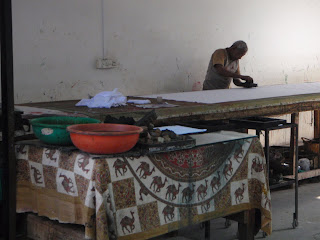

About 1:15, we returned to the hotel where we ate lunch before returning to the room. At 4:30, we left the hotel and drove into the countryside. A bus ride over a dirt road for a couple of kilometers was part of the adventure. Once we arrived at Dera Amer, our destination, we enjoyed a welcome drink before an elephant ride through a portion of the Aravali Forest. Our howdahs were rectangles strapped atop the elephant’s back; while these were steel and modern, they are in the style of hunting howdahs. We sat facing each other. We traversed a circular path, returned to our starting point and dismounted. We then went to an open-sided structure where the ladies received scarves and a lady painted henna designs on their hands. A man tied turbans on the men. After drinks, listening to Indian music and watching some traditional dancing and a fire-eater; we enjoyed dinner under pavilions. It was around 9:30 when we returned to the hotel.
Tour – Day 11: We had arranged to meet Raj at 10:00 for a trip to Agra Handicrafts. Although the group schedule called for a trip there in the afternoon, we didn’t want to chance it. We saw a master demonstrate block printing including the color change when the fabric is washed after dying. Then we went inside and shopped the textile department. We then went across the hallway to the handicraft section. It was 11:30 when Raj returned us to the hotel. 

After lunch, we waited in the lobby until time to leave at 2:00. As predicted, our first stop was Agra Handicrafts. The staff treated us special; we even got the little elephant print from this morning’s block print demonstration. Several in the group bought items here. From there we went to the City Palace, the royal residence of the Maharajah of Jaipur. Inside we saw several elaborate costumes as well as some huge silver jars used by the Maharajah to carry Ganges water with him to London for the coronation of King George V in 1902. We enjoyed seeing the museum portion of the palace and the exterior of the portion where the royalty currently resides.

 .
.


 Inside we saw several elaborate costumes as well as some huge silver jars used by the Maharajah to carry Ganges water with him to London for the coronation of King George V in 1902.
Inside we saw several elaborate costumes as well as some huge silver jars used by the Maharajah to carry Ganges water with him to London for the coronation of King George V in 1902.
We enjoyed seeing the museum portion of the palace and the exterior of the portion where the royalty currently resides.

After a drive through the modern portion of Jaipur, we arrived at the airport. “Kingfisher Airlines” is bankrupt; our flight number 302 was the last scheduled flight from Jaipur to Udipur on that airline. It was scheduled for 7:45 and we finally took off about 8:20.
UDAIPUR
Hotel: The Taj Lake Palace Hotel. A former summer palace of the Mewar Maharana of Udaipur, is located on an island in the middle of a lake and must be reached by boat. The room is small with painted floral panels on the walls, a marble frieze and ceiling, inlaid marble floor and built in sofas. They did a good job of creating rooms from former open spaces. We had a view of the City Palace from our window and at breakfast saw the Monsoon Palace perched high atop a nearby hill. Food and service were excellent.
Tour – Day 12: There was a Maharajah in Jaipur; “maha” means great and “rajah” means ruler or king. In Udaipur, there is a Maharana; “maha” means great and “rana” means warrior. At 10:00, we took a boat back to shore and began a walking tour. Our first stop was Jagdish Temple built in the 16th century and dedicated to Lord Vishnu. We climbed a very steep and tall set of stairs to reach the temple platform. A blue statue of Lord Vishnu stood behind the altar. After walking around inside, we exited and circled the exterior to look at the carvings. A large statue of a garuda stands outside the temple doorway ready to fly Lord Vishnu on his journeys.
From there we entered the City Palace, home to the Mewar Mararanas, a fifteen-hundred-year-old-dynasty. We entered through the “Tripolia” gate and also saw the “Balcony of the Sun” before entering the museum portion; there were a lot of narrow stairways and hallways and much of the tour was single file. One public audience courtyard was magnificently inlaid with glass and stone in peacock designs and an adjacent dining room’s décor relied heavily on mirrors and glass mosaics for its decor. We also saw some of the apartments belonging to the grandmother of the present Maharana. Several palanquins and howdahs in different styles lined one portico; all were covered with heavy dust-encrusted plastic to preserve them. The royal family still lives in one portion and several other portions are hotels.









 After leaving the palace, we boarded the bus and drove to a place where miniature painting techniques were demonstrated. We saw how the colors are created from minerals and the brushes from camel eyelashes and/or squirrel hair.
After leaving the palace, we boarded the bus and drove to a place where miniature painting techniques were demonstrated. We saw how the colors are created from minerals and the brushes from camel eyelashes and/or squirrel hair. 

From there, we returned to the hotel for lunch about 2:30. At 5:00 we met for a cocktail cruise on the lake. We boarded a 175-year-old boat for the cruise during which we were served drinks and canapés. It was pleasant on the lake. At one point, dancers performed in a waterside portico of the City Palace. After sailing near the other island palace now used for private functions, we watched the sun set behind the mountains. A brief fireworks show at twilight ended the cruise.

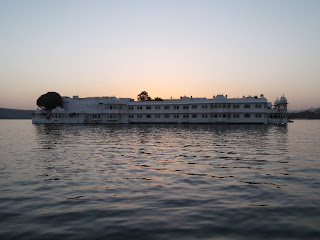

MUMBAI
Hotel: Taj Mahal Hotel around 6:00, were given a welcome drink and garland, and escorted to room 329 in the historic section of the hotel. Gifts of bangles, sparkles for foreheads, and a scarf awaited us.
Tour – Day 13: At 1:00 we boarded the boat and sailed to the lakeside where we boarded the bus for the half-hour trip to the airport. Our original “Jet Airways” flight was canceled and we flew “Air India” flight 471 to Mumbai. We left around 3:20 and landed about 4:45. We met Sandy, our local guide, and boarded a bus for the trip to the hotel. She gave a witty and informative commentary on the drive. The city was once called Bombay, a corruption of Portuguese for "good bay," and the name was changed to Mumbai, the name of a tribe of original inhabitants of the area. Mumbai is a large, cosmopolitan city and doesn’t appear to belong to the traditional India we saw before today. There are lots of tall buildings here. At 7:30 we met in the Zodiac Grill for drinks and the “Farewell Dinner.”
Tour – Day 14: We left for our Mumbai tour at 9:30. With Sandy narrating, we saw the British Colonial City of Mumbai. The Gateway of India is just outside our hotel. We stopped at the university to make photos of the Gothic structure and of the Rajabai Tower, a Big Ben lookalike.
We also saw the Court Building. Across from the City Hall, we stopped and went into Chhatrapati Shivaji Terminus, the former Victoria Station. This is the terminus of the Indian Railway and millions of people pass through it daily. Because women comprise a large part of the work force in Mumbai, some cars are designated “women only.” A second class ticket costs 4 IR and a first class ticket costs 41 IR. We even walked through an empty car before exiting the station and returning to the bus.
We drove along Chowpatty Beach and through neighborhoods. We also drove through a slum area.
On a visit to Crawford Market, we saw lots of fruits and vegetables. Sandy explained that for the price of 4 kilos of meat, a vegetarian family can eat for a week.




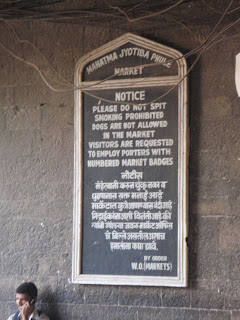




Then we went to see Dabbi Walla in action. This is the process of picking up lunches at working men’s homes, delivering them to the office, and then returning the empty containers. We saw hundreds and hundreds of containers as they were brought from the train stations, sorted, loaded onto handcarts or bicycles, and headed for distribution. We don’t understand how it works but were assured that it is entirely accurate.

We then visited the Ghandi Memorial Library before returning to the hotel for lunch about 2:00.

After eating the buffet lunch in the coffee shop, we left again. This time we saw the Hanging Gardens constructed atop the concrete roof of a reservoir.

Nearby are the Towers of Silence where the Zoroastrians dispose of their dead.

We then went to see Dhobi Ghat, the area where men launder anything brought to them. Clothes and linens are washed outside in running water and beaten on concrete blocks to knock the dirt from them. Then they are hung on lines to dry before being ironed. It was after 5:00 when we returned to the hotel.




COCHIN
Hotel: Vivanta by Taj – Malabar Cochin located on Willingdon Island. This hotel was somewhat uncomfortable and comparable to an old-fashioned “Holiday Inn” without amenities.
Tour – Day 15: We flew from Mumbai to Cochin landing about 3:30, we deplaned, claimed the luggage, and made our way to the bus. Southern India is green and hot; it’s 95 today. The state is Kerala and lies between the Western Ghats (mountains) and the Arabian Sea. Reminiscent of south Louisiana, it has a number of lakes, rivers and backwaters. The Portuguese were the first Europeans to arrive here in their quest for spices and called the area Malabar. They were shocked to find that Orthodox Christians, Arabs and Jews already lived here. The Portuguese set out to exterminate the Arabs and Jews because they were heretics and because they were competetitors for the spices. The economy seems to be good here and it’s not as crowded. The predominant language here is not Hindi; it’s Malayalam. Aji, our guide, spoke about Southern India and the state of Kerela on the way to the hotel. At 6:30, we attended a private performance of “Kathakali,” a traditional Indian dance relying on heavy make-up, stylized gestures and steps, and dramatic eye movement.
Tour – Day 16: With Aji as our guide, we headed into Cochin. We visited the community of Mattancherry. This location was given to the Jews by the Maharajah to keep them close to his palace and give them protection from the Portuguese. Two of the sites we were to see, the Dutch Palace
and the Paradesi Synagogue,
were closed on Fridays. There was a Hindu Temple on the ground floor of the palace, but non-Hindus are not permitted to enter temples in this portion of India. We wandered the streets of Jew Town,
We saw the Jewish Cemetery and entered a spice shop. There are only 8 Jews residing in Cochin and most of them are quite elderly. In one shop we looked at one of the wooden “Snake Boats” used in races; the stern is high and carved and the prow juts a long way over the water. It takes quite a few oarsmen to propel it. Once back aboard the air-conditioned bus, we drove a short distance to visit St. Francis Church. Originally constructed as a Roman Catholic Church by the Portuguese in 1510, Vasco de Gama was entombed here before his body was moved to Lisbon. The Dutch changed the church to a Dutch Reformed Church and the British East India Company changed it to Anglican.

 Several former British homes remain here and are estates serving as homes to the wealthy.
Several former British homes remain here and are estates serving as homes to the wealthy.
We then walked down to the edge of the backwater to see the Chinese Fishing Nets, butterfly nets cantilevered over the water and lowered and raised by the use of huge, counter-balanced rocks. They have been a fixture here since around 1400.




KUMARAKOM
Hotel: The main building of the Vivanda Kumarakom Hotel is a bungalow used by a British farming family for four generations that has been converted. Rooms are individual villas scattered across the grounds. We’re in 33, half a duplex with a large sitting area attached to the sleeping area. There is a nice covered verandah on the back. While the sleeping and sitting area is air conditioned, the attached bathroom is open-air.
We decided to have lunch in our next hotel and began the hour-and-a-half drive. For the most part there were settlements along the roadway and while many appeared prosperous, none appeared affluent. Coconut groves and rice paddies abound. Hindus, Christians and Muslims appear to live in harmony here. Upon arrival at the hotel about 1:30, we ate lunch together before being shown to our villas. Shortly before 7:00, we walked down to the edge of Vembanadu Lake to see the fruit-eating "flying foxes" [fruit bats] begin their nightly hunting.
 We were amazed at the cool breeze coming off the lake that never reached the interior of the resort.
We were amazed at the cool breeze coming off the lake that never reached the interior of the resort.
Tour – Day 17: After lunch, we walked down to the edge of the lake where we sat under a pavilion enjoying the cool breeze until after 3:00. We relaxed in the room until shortly after 5:00 when we walked to the lakeside to see the sunset.

We returned to the room for a while before walking up to the café about 7:00. We saw the ladies place the lights around the edge of the lagoon and then got a table for dinner. We had good seats for the music and dance program which began after 8:00.
Tour – Day 19: The morning’s tour was through area villages. We stopped at two churches: Kottayam Cheriapally – Orthodox Maha Edavaka-St. Mary’s Church (1579) and Kottayam Valiyapally – St. Mary’s Knanaya Church (1550). Both these are Syrian Orthodox Churches. At the first one, services were over and a member showed us around even opening the drape hiding the altar for us. At the other church, services were just ending and we peeked inside during the time the priest was blessing the women. This church is older, larger and more ornate. A feature of each is a tall, gilded “flagpole” which stands outside.






This is rice farming country and we saw lots of paddy fields.
KUMARAKOM TO TODDAPULLY
We returned to the hotel to board a “kettavalum” or houseboat for a cruise over Vembanadu Lake and then through a canal as we made our way to Toddapully.


We had lunch and drinks aboard. Most of the water is shallow and the shores are palm-fringed. Rice paddies line some canals. Coir (coconut fiber) is made here and we saw miles of string and rope make from this. We also saw jackfruit and cashew trees. Daily life occurred ashore as we drifted until around 3:00.



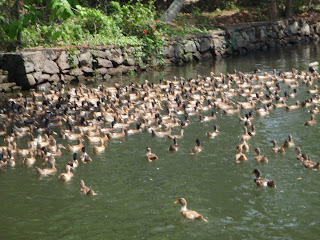






 This boat trip was one of the highlights of the entire tour.
This boat trip was one of the highlights of the entire tour.
Shortly before we reached the border with Kovalum, we saw elephants. Today was a festival day for Hindus and eight elephants were decked out with red and gold finery. Two mahouts atop each held a gilded image of the deity and a parasol. We made photos as they were organizing a procession to a nearby temple where there would be almost 100 elephants. We reached the “Cashew Capital of the World” when we reached Kovalum. We spent the next four-plus hours driving toward our hotel. Along the roadway we saw village life as well as Christian churches, Hindu temples and Muslim mosques. It was a long and somewhat exhausting drive.



KOVALUM
Hotel: Around 7:00 we reached Vivanta by Taj (Taj Green Cove) – Kovalum-Kerala. This resort perches on a rocky cliff across the highway from the Arabian Sea. It’s all various levels with no lift, so we climbed lots of stairs to reach room 308. We really couldn’t tell much about the hotel because it was dark and poorly lighted. The hotel was much more manageable in the daylight.
Tour – Day 20: At 8:30, we met the group for an hour-and-a-half tour. We saw Lighthouse Beach before driving to a fishing village to see the day’s catch. We saw three large mosques and a Christian church.
before driving to a fishing village to see the day’s catch. We saw three large mosques and a Christian church.
 before driving to a fishing village to see the day’s catch. We saw three large mosques and a Christian church.
before driving to a fishing village to see the day’s catch. We saw three large mosques and a Christian church. 




The people were not welcoming but they were tolerant of our presence. We returned to the hotel and spent the remainder of the day relaxing. At 6:30 we met the group in the bar for cocktails and then went to the seafood restaurant for dinner
Tour – Day 21: We got up around 7:00 and began to get ready to begin the long journey home. We met Harry, the local agent, in the lobby around 11:30 and he told us that the flight was delayed. He also learned that we were unable to check the bags all the way through to DFW. Travcoa’s agents in Mumbai booked us a day room at the Hilton with transfers to and from. We left the hotel about noon and drove to the Trivendrum Airport where we checked in for “Jet Airways 2307” scheduled for 1:35. Security here was a nightmare as we had to open each carry-on while they took out items to scan separately. By the time it was over, we weren’t sure we had everything back where it belonged. It was more of a “training exercise” than a real check. We actually took off around 2:30. We did some doughnuts before landing in Mumbai about 4:30. We met our contact in baggage claim. When the luggage finally arrived, we made our way curbside where a driver loaded the luggage into the van. It took 12 to 15 minutes to get to the Hilton where we checked into room 218. We ate sandwiches in the Brasserie and then returned to the room to compute and bathe before being picked up at 11:45.
Tour – Day 22: LH 757 scheduled departure time for Frankfurt is 3:15 a.m. After checking in at the airport and going through Immigration and Security, we made our way to the Lufthansa Business Lounge. I missed a stamped bag tag before leaving Security and they replaced it with no problem. Boarding went OK for us but there was still someone checking to make sure the tags were stamped. This cabin was configured like the one on the Frankfurt to Delhi flight. We did not depart at 3:15 but had to wait for a half hour. Boarding took so long that we overlapped the normal “thirty minute runway closure” that occurs nightly. Finally, we taxied and took off. We slept for most of the flight. Arriving on time in Frankfurt, we deplaned and rechecked our departure gate. Then we made our way to the lounge to wait; we only had about an hour’s free time.







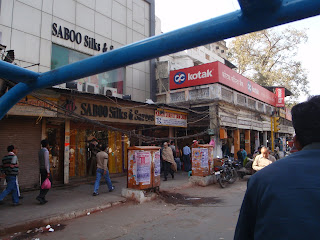



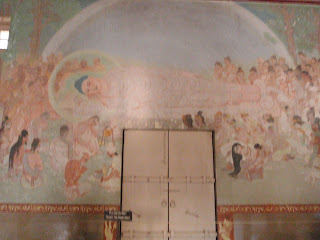




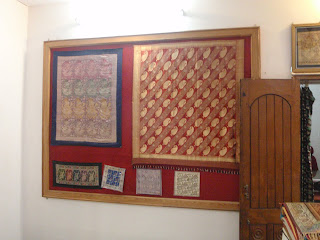



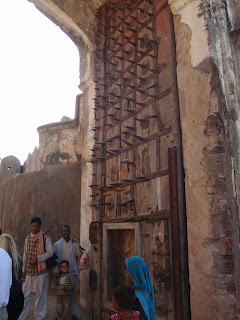




























 .
.










